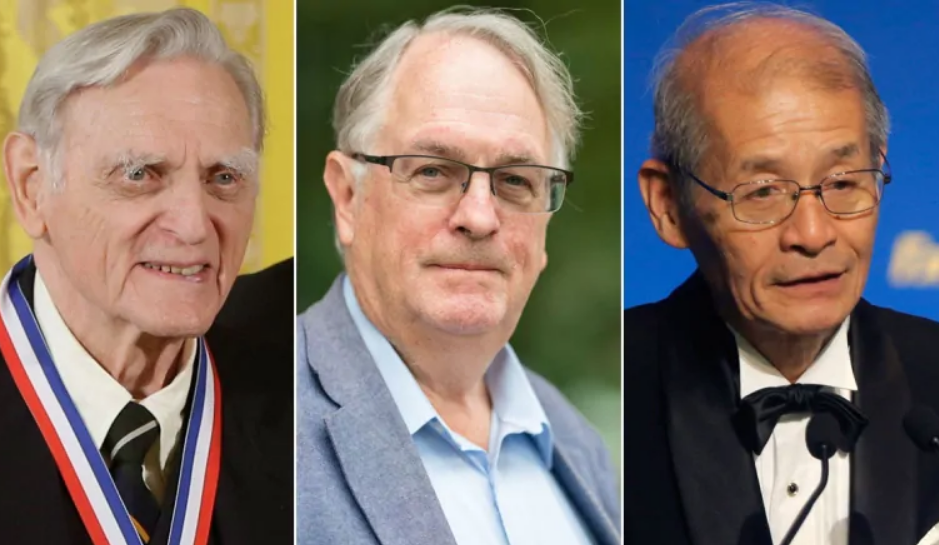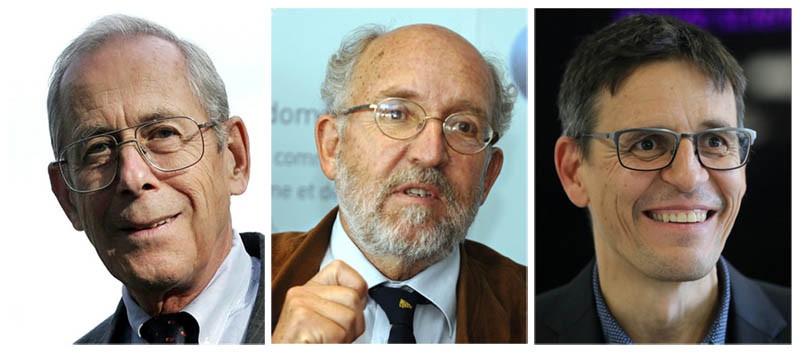The Trio of Lithium-Ion Battery Discovery Wins Nobel in Chemistry

The most coveted Nobel Prizes are known for awarding and recognizing scientific discoveries that have made phenomenal difference to the world. This year’s Nobel in Chemistry is awarded for the pioneering discovery of Lithium-ion battery- paving the way for smartphones and a fossil fuel-free society. Such storage batteries that are small and have longer operating duration have created a paradigm shift in the field of electronics. This revolutionary invention is shared among 3- as the electrons in the lithium atom- Stanley Wittingham, John Goodenough and Akira Yoshino.
Seeking an alternative source of power during the oil crisis of the 1970’s, Wittingham who was working at Exxon on superconductors discovered that the combination of titanium disulphide and metallic lithium at the cathode of a battery would harness immense potential energy. As lithium releases a lot of electrons and is very reactive, it was prone to explosions. He constructed a 2V battery partly made of lithium. However, it was too unstable to be used.
Further to Wittingham’s work, John Goodenough substituted titanium disulphide with cobalt oxide in the cathode, producing a battery with double potential. This paved the way in not only making efficient and durable batteries but also in making John, the oldest, at 97 to receive the Nobel Prize.
Winning the Nobel Prize is undoubtedly one of the most exhilarating moments in a scientist’s life. When asked about his reaction on winning the Nobel, John said that he was pleased and moreover surprised. He assumed he was too old to have received this honour. But even at this age he still works in the laboratory researching. He also said that he would not want to retire and just wait for death to come. He is a passionate researcher with immense love for science.
He further added that “Our innovations are morally neutral and it depends on how we use the. So if people use the lithium-ion battery well. I am delighted.”
Although John’s work was better, it just wasn’t good enough to be commercially viable.
In 1985, Akira Yoshino perfected the batteries by going a step ahead and created the first commercially viable lithium-ion battery, amid Japan’s increasing push for lightweight, high-capacity batteries. He used petroleum coke, a carbon-based byproduct of the oil industry, in the anode. This eliminated the used of pure lithium, which is extremely reactive.
The change resulted in a rechargeable and durable battery. Since 1991, when lithium-ion batteries made their commercial debut, they have come a long way and made wireless devices and renewable energy viable.
Oxygen is More than Just the Gas You Breathe!
Medicine Nobel Laureates Awarded for Research in Physiological Processes
The 2019 Nobel Prize for Medicine or Physiology was jointly awarded to Sir Peter J. Ratcliffe, William G. Kaelin Jr, and Gregg L. Semenza for their discoveries of “how cells sense and adapt to oxygen availability”. Animals need oxygen for the conversion of food into useful energy. The fundamental importance of oxygen has been understood for centuries, but how cells adapt to changes in levels of oxygen has long been unknown.

The trio discovered how cells can sense and adapt to changing oxygen availability and identified molecular machinery that regulates the activity of genes in response to varying levels of oxygen. They established the basis for our understanding of how oxygen levels affect cellular metabolism and physiological function. Their discoveries have also paved the way for promising new strategies to fight anemia, cancer and many other diseases.
Gregg Semenza studied the EPO gene and how it is regulated by varying oxygen levels. Sir Peter Ratcliffe also studied O2-dependent regulation of the EPO gene, and both research groups found that the oxygen sensing mechanism was present in virtually all tissues, not only in the kidney cells where EPO is normally produced. These were important findings showing that the mechanism was general and functional in many different cell types.
Semenza discovered a protein complex that binds to the identified DNA segment in an oxygen-dependent manner. He called this complex the hypoxia-inducible factor (HIF). Semenza was able to publish some of his key findings, including identification of the genes encoding HIF. HIF was found to consist of two different DNA-binding proteins, so called transcription factors, now named HIF-1α and ARNT.
HIF-1α is normally degraded rapidly, but is protected from degradation in hypoxia. At normal oxygen levels, a cellular machine called the proteasome degrades HIF-1α. Under such conditions a small peptide, ubiquitin, is added to the HIF-1α protein. Ubiquitin functions as a tag for proteins destined for degradation in the proteasome. How ubiquitin binds to HIF-1α in an oxygen-dependent manner remained a central question.
The answer came from an unexpected direction. At about the same time as Semenza and Ratcliffe were exploring the regulation of the EPO gene, cancer researcher William Kaelin, Jr. was researching an inherited syndrome, von Hippel-Lindau’s disease (VHL disease). This genetic disease leads to dramatically increased risk of certain cancers in families with inherited VHL mutations. Kaelin showed that the VHL gene encodes a protein that prevents the onset of cancer. He also showed that cancer cells lacking a functional VHL gene express abnormally high levels of hypoxia-regulated genes; but that when the VHL gene was reintroduced into cancer cells, normal levels were restored. This was an important clue showing that VHL was somehow involved in controlling responses to hypoxia. Ratcliffe and his research group then made a key discovery: demonstrating that VHL can physically interact with HIF-1α and is required for its degradation at normal oxygen levels. This conclusively linked VHL to HIF-1α.
Nobel Prize in Physics for Cosmology
The Royal Swedish Academy of Sciences honored scientists for changing how we think of the cosmos. The Nobel Prize in Physics 2019 “for contributions to our understanding of the evolution of the universe and Earth’s place in the cosmos” is shared among 3 scientists. With one half to James Peebles of Princeton University “for theoretical discoveries in physical cosmology” and the other half jointly to Michel Mayor of the University of Geneva and Didier Queloz of the University of Geneva, Switzerland and the University of Cambridge, UK.
It is significant that all three winners of the 2019 Physics Nobel worked in space-themed areas in a year when important space events are being celebrated. These include the 50th anniversary of the first manned landing on the moon, the 50th year of Isro and the 100 birth anniversary of the father of the Indian space programme, Vikram Sarabhai.

In October 1995, the duo announced the first discovery of a planet outside our solar system. Using custom-made instruments, they spotted the Jupiter-like planet 51 Pegasi b from the Haute-Provence Observatory in southern France. Today, more than 4,000 exoplanets have been spotted in the Milky Way, and the discoveries keep on coming.
James Peebles’ work brought light on the universe’s structure and history and laid the foundations for cosmology for the past 50 years. The big bang model describes how the universe evolved over nearly 14bn years from a hot, dense ball to the vast, cold and expanding universe of today.
With theoretical tools and calculations, James Peebles interpreted these traces from the infancy of the universe and discovered new physical processes. He found that only 5% of the observable universe is known to us in the form of stars, planets and people. The remaining 95% is mysterious and made up of what physicists call dark energy and dark matter. So-called dark energy is said to drive the expansion of the universe, while dark matter is the invisible substance that appears to hang around galaxies, revealing itself only by its gravitational draw.
James Peebles left a footprint in Mumbai when he visited TIFR in 2011. He gave lectures and interacted with scientists and even laypersons, according to Pankaj Joshi, a cosmologist who was with the institute, and is now director of the International Centre for Cosmology near Anand in Gujarat. After visiting a few labs and interacting with scientists working in the field of cosmology, Peebles provided useful scientific observations and comments which were well appreciated.






























